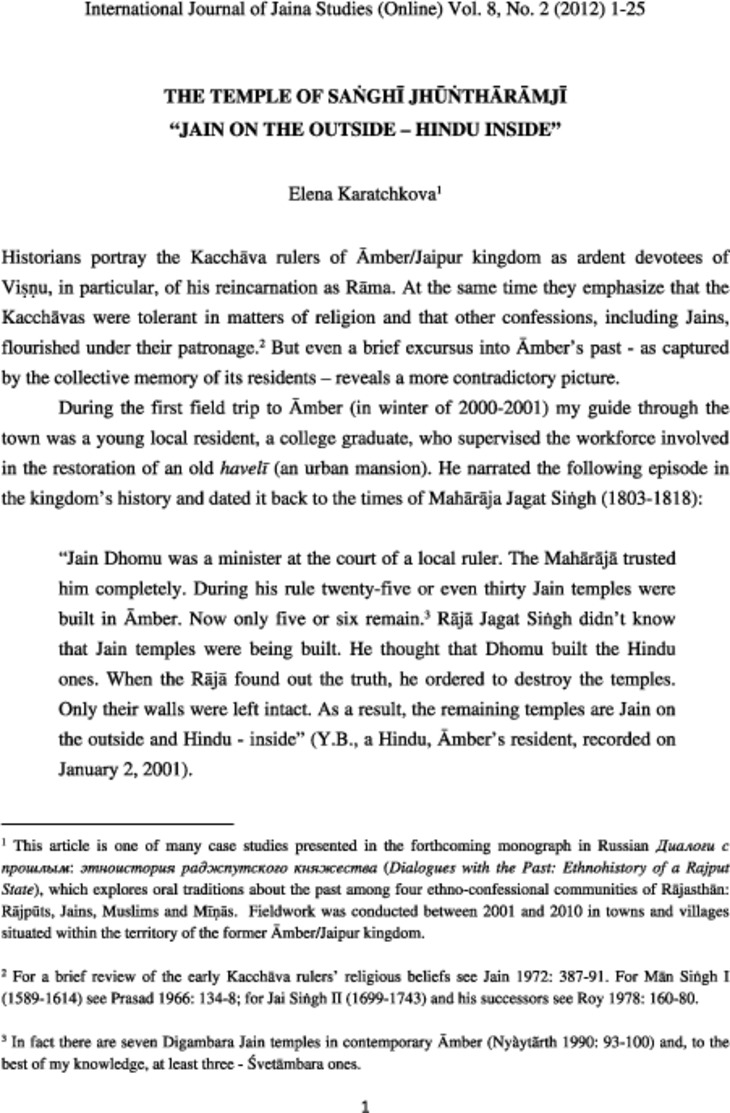
International Journal of Jaina Studies
(Online) Vol. 8, No. 2 (2012) 1-25
Abstract
This paper analyzes an oral tradition (recorded during field research), which explains the circumstances of religious conversion of a temple in Āmber - the former capital of Jaipur kingdom in Rājasthān. The Śaiva temple, today referred to locally as “Saṅghī Jhūṅthārāmjī kā mandir”, was originally the Jain temple of Vimalnāth. It was built in 1657 A.D. by Mohan Dās - the Jain Chief Minister at the court of the Rājpūt ruler of Āmber Rājā Jai Singh I (1621—1667). In this paper I compare the content of the recorded narrative about the temple with historical circumstances of its conversion. Although the contemporary oral tradition contradicts historical facts, it reveals important social and cultural meanings, characteristic of Rājasthān.
Elena Karatchkova
This article is one of many case studies presented in the forthcoming monograph in Russian Диалоги с прошлым: этноистория раджпутского княжества (Dialogues with the Past: Ethnohistory of a Rajput State), which explores oral traditions about the past among four ethno-confessional communities of Rājasthān: Rājpūts, Jains, Muslims and Mīṇās. Fieldwork was conducted between 2001 and 2010 in towns and villages situated within the territory of the former Āmber/Jaipur kingdom.
The Temple of Saṅghī Jhūṅthārāmjī Jain on the Outside – Hindu Inside
Historians portray the Kacchāva rulers of Āmber/Jaipur kingdom as ardent devotees of Viṣṇu, in particular, of his reincarnation as Rāma. At the same time they emphasize that the Kacchāvas were tolerant in matters of religion and that other confessions, including Jains, flourished under their patronage. [1] But even a brief excursus into Āmber's past - as captured by the collective memory of its residents reveals a more contradictory picture.
During the first field trip to Āmber (in winter of 2000-2001) my guide through the town was a young local resident, a college graduate, who supervised the workforce involved in the restoration of an old havelī (an urban mansion). He narrated the following episode in the kingdom's history and dated it back to the times of Mahārāja Jagat Siṅgh (1803-1818):
"Jain Dhomu was a minister at the court of a local ruler. The Mahārājā trusted him completely. During his rule twenty-five or even thirty Jain temples were built in Āmber. Now only five or six remain. [2] Rājā Jagat Siṅgh didn't know that Jain temples were being built. He thought that Dhomu built the Hindu ones. When the Rājā found out the truth, he ordered to destroy the temples. Only their walls were left intact. As a result, the remaining temples are Jain on the outside and Hindu - inside" (Y.B., a Hindu, Āmber's resident, recorded on January 2, 2001).
The central motif of this narrative of a benevolent but gullible ruler and his scheming minister was obviously folkloric in its nature. Despite clear chronological attribution the reign of a 19th century Mahārājā it did not necessarily constitute a historical fact. But the reference to a communal conflict suggested a possibility of a counter narrative, which prompted me to look further into the matter in search of the "Jain side of the story". Further inquiries in Āmber conducted in 2002-2003 confirmed that the Hindu-Jain conflict remained preserved in local residents' collective memory. Many respondents from various communities narrated similar stories of Jain temples' conversions, but attributed these events to the ruling periods of different Mahārājās: starting with Mān Siṅgh I (1589-1614) and up to the already mentioned Jagat Siṅgh. Material evidence supported oral testimonies: following the leads offered by my respondents, I have come across two temples within the old town walls, which still bear clear signs of conversion.
The First Converted Temple of Āmber: Saṅghī Jhūṅthārāmjī
It is a grand and fairly well-preserved temple with three tapering spires (a tīn-śikhara) and a round dome, situated off Sāgar road. A standard information plate installed at the entrance, informs visitors that this architectural monument is protected by the Government of Rājasthān, but contrary to the texts on other similar plates, it does not mention the name or the date of its construction, says nothing about its historical significance or artistic value. Despite the large hand-made inscription in Devanāgarī on the wall, surrounding the temple grounds, which says: Rudrā Mahādevjī kā mandir[3], local residents keep referring to it as Saṅghī Jhūṅthārāmjī kā mandir[4]. A photograph of the temple displayed in a small archeological museum on the premises of Āmber Fort and Palace complex is signed: "Saṅghī Jhūṅthārāmjī, 1657". The museum guide could not or would not provide any additional information.
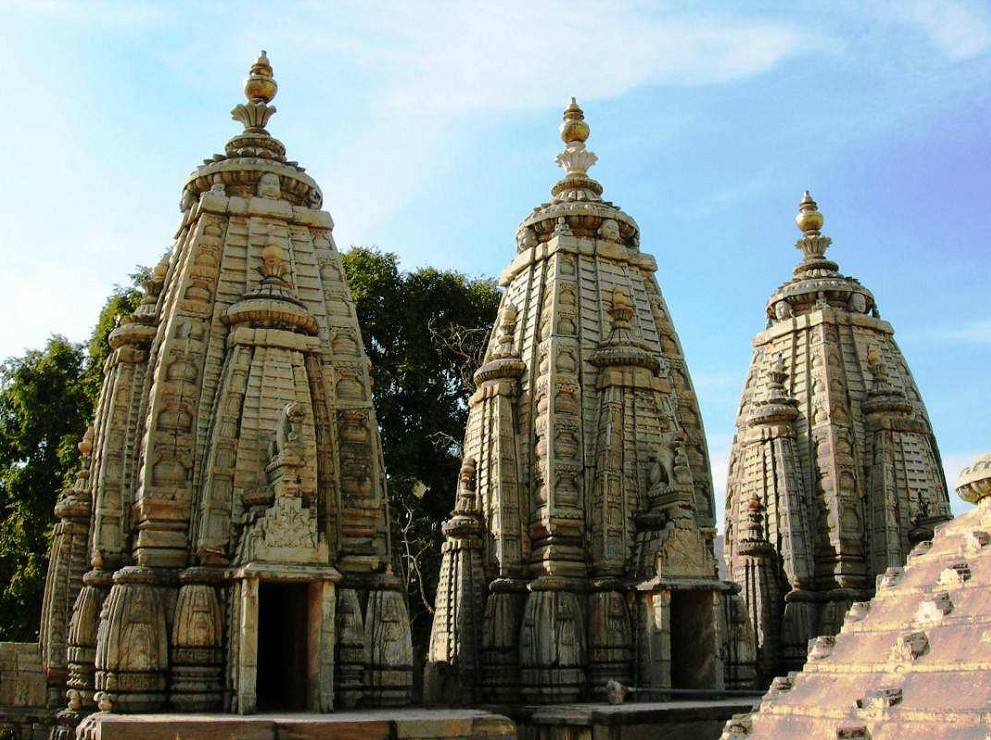
Traces of temple conversion are still visible: small marble bas-reliefs of Jinas above the main entrance, which leads into the inner court yard; similar images above the door to the altar room. A huge square marble platform in the middle of the altar room contains images of a p7c-mukhī (five-faced) liṅgam and bull Nandī. Pārvatī and Gaṇeś occupy a pillared verandahlike structure on the far side of the platform. Present in many Jain altars of Āmber and Jaipur, this structure imitates the setting of a medieval darbār, inside which Jinas are enthroned. In short, the altar in Saṅghī Jhūṅthārāmjī is a typical Jain altar, but populated with Śaiva images. The priest confirmed that his temple had indeed been converted. He said that it happened long time ago, during the rule of Rājā Mān Siṅgh I, whose Jain minister by the name of Jhūṅthārām built this temple. Behind the ruler's back the minister started to use the temple as the center of proliferation of his dharma. When Mān Siṅgh learnt about it, he ordered to take all the Jain images outside and to replace them with liṅgams (Interview with the priest of Saṅghī Jhūṅthārāmjī, recorded on March 1, 2003).
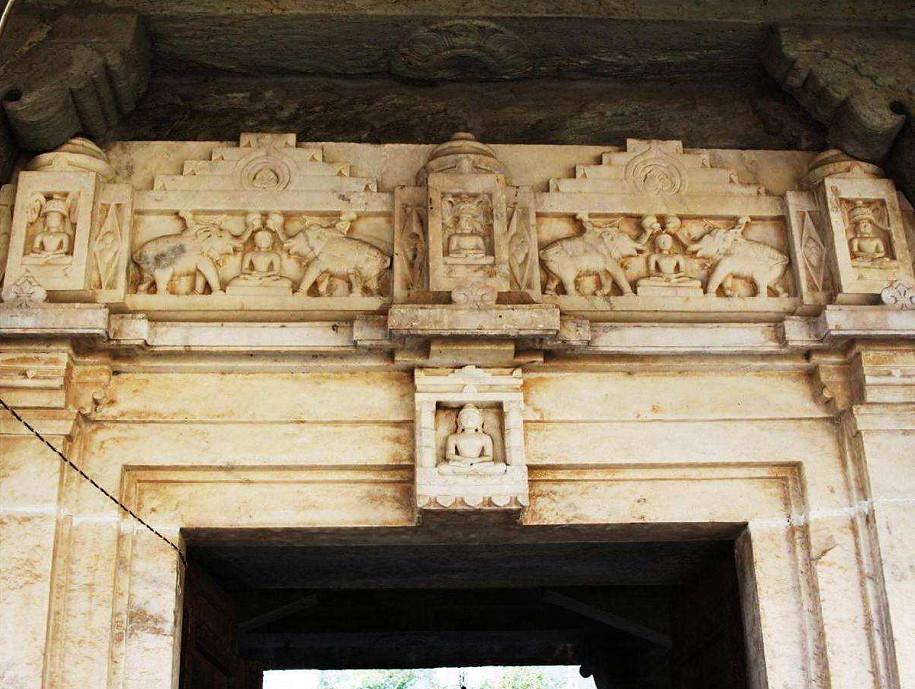
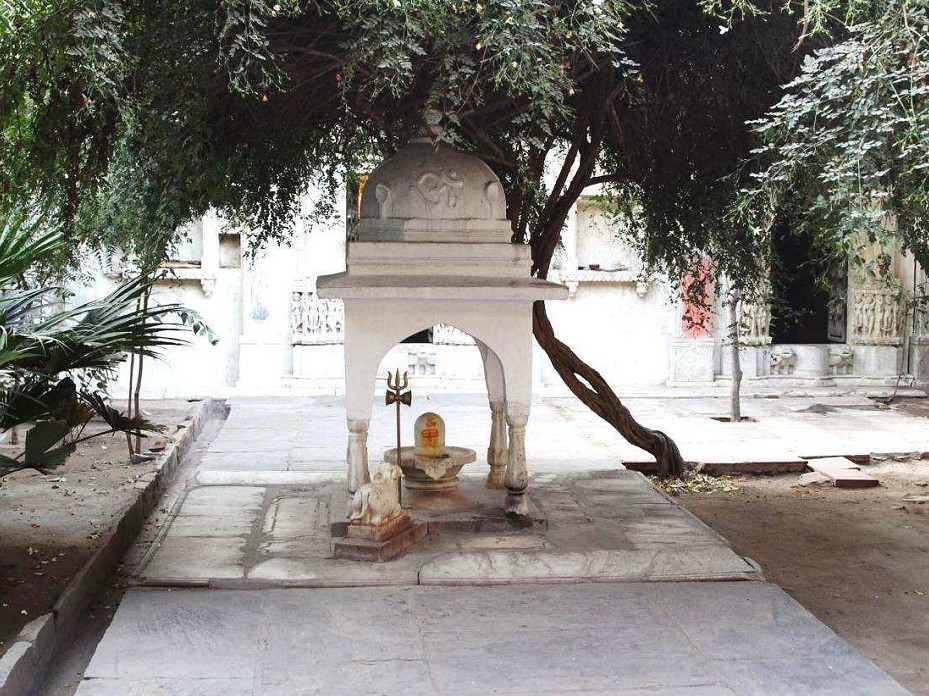
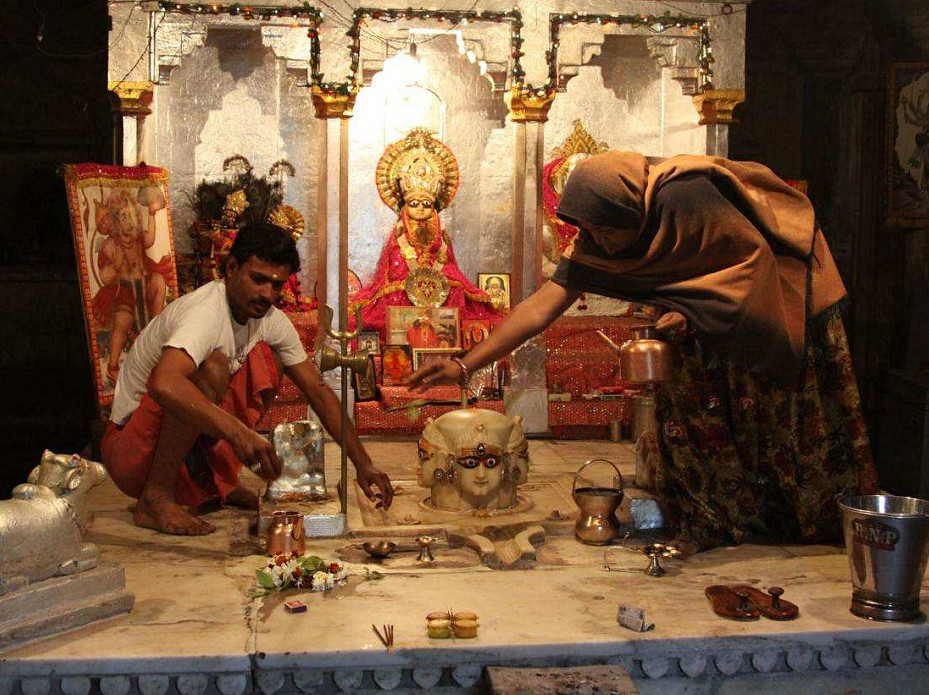
The Second Converted Temple of Āmber
The second converted temple of Āmber, located on the left side of the old road Jaipur - Delhī, is now occupied by the Boys' Secondary School. The building seems to be a later and smaller copy of the first one: another "tīn-śikhara" with a dome, an inner courtyard and the main room with a square altar in the middle. The altar is a modest replica of the one in the first temple: a stone platform with a pāñc-mukhī liṅgam and a herd of Nandī bulls of various calibers; Pārvatī and Gaṇeś inside the pillared verandah, adorned with a bas-relief of a Jina, surrounded by two elephants. The altar room serves today as teachers' lounge. Those present agreed to answer my questions: the school had been situated on these premises for at least 50 years; they don't know what used to be here before that, and whether it used to be a Jain temple; the temple doesn't have a name and pūjās are not performed here (Interview with the school teachers, recorded on February 10, 2003). Yet the liṅgam in the altar was adorned with fresh flowers and yellow tilaks shone brightly on Nandīs' foreheads.
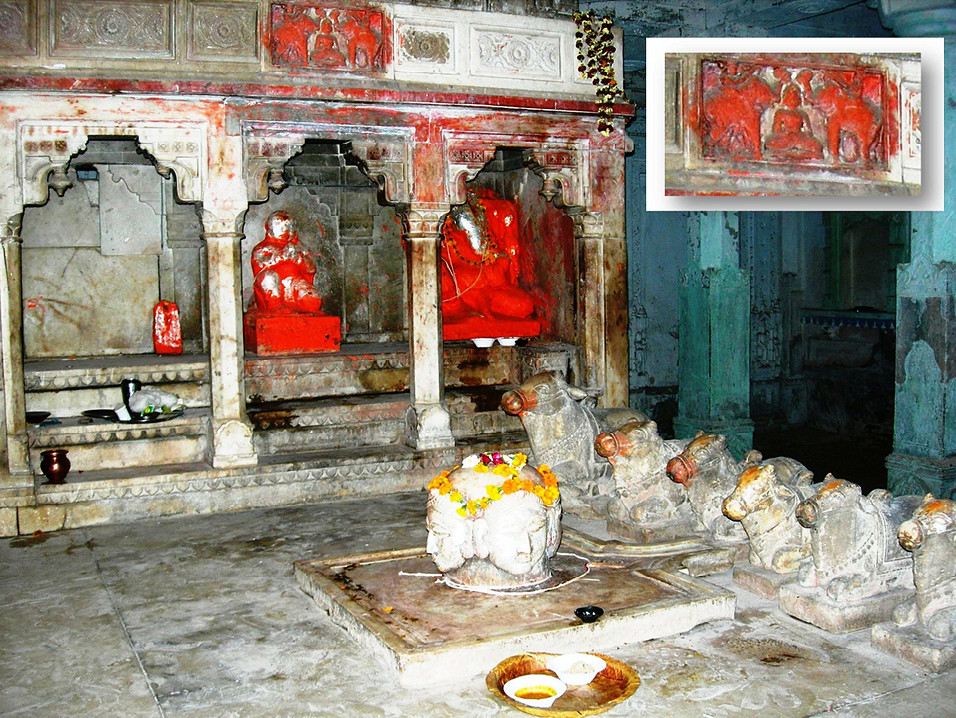
All attempts to retrieve an alternative version of events from few Āmber Jains[5] were unsuccessful. In response to my questions they invariably suggested that I talked to "someone more knowledgeable", "to a Jain person of authority in Jaipur". This was accomplished much later, and the results of the Jaipur part of investigation will be discussed below.
Historians of Āmber/Jaipur kingdom helped to shed some light on the temple's destiny. In K.C. Jain's (1972: 387-93) classic monograph Ancient Cities and Towns of Rajasthan: a Study of Culture and Civilization there is short chapter on Āmber, in which the author discusses the process of proliferation of Jainism in the kingdom during the period between the reign of Rājā Bharmāl (1548-1570) and the foundation of Jaipur in 1727. Most important for my purposes, he mentions an inscription on a stone plate dated 1657 A.D. "in a Jain temple of Amber", which says, that Mohan Dās, the Jain chief minister of Rājā Jai Singh I (1621-1667) built the temple of Vimalnāth and adorned its śikharas with golden pinnacles (kalaśa) (ib., p. 392). B.L. Dhama (1955: 73), who supervised the Jaipur branch of ASI (Archeological Survey of India) in 1940s, clarifies that the above mentioned plate "was once lying in Sunghi Jhunta Ram's temple at Amber, and is now in the custody of the Archeological Department of the Rajasthan Government".
Therefore we may conclude that the Śaiva temple of Rudrā Mahādev, invariably referred to by local residents as Saṅghī Jhūṅthārāmjī, was originally the Jain temple of Vimalnāth, and dates back to the middle of the 17th century. K.C. Jain emphasizes religious tolerance of the Kacchāva rulers and draws a picture of steady and uninterrupted flourishing of Jainism in Āmber kingdom between the middle of the 16th century and up to the 1730s. He does not mention any episodes of Jains' persecution or of their temples' desecration during the Āmber period of the kingdom's history, including the times of Jai Siṅgh I and his Jain chief minister Mohan Dās. Therefore the oral tradition, which I recorded and reproduced in the beginning of this paper, formed later. Why did it develop? When and under what circumstances was the Jain temple of Vimalnāth converted? And, finally, who was Saṅghī Jhūṅthārām, and why does the temple bear his name?
The First Episode of Jain Temples' Conversion
A prominent historian of Jainism in Rājasthān K.C. Kasliwal (1982: 153-9) also describes the Āmber period of the kingdom's history as favorable and prosperous for the Jain community. In the middle of the 16th century (during the reign of Rājā Bharmāl) the "throne" (gaddī) of bhaṭṭāraks[6] moved from Delhī to Āmber and settled in the temple of Nemināth[7]. It was active all through the history of Āmber as the first capital of the Kacchāvas. When the court moved to the newly-built Jaipur, bhaṭṭāraks followed and established their "throne" in one of the oldest Jain temples of Jaipur the Pāṭodī temple.
During the reign of Mahārājā Mādho Siṅgh I (1751-1768) and at the very beginning of his son and successor Pṛthvī Siṅgh's rule (1768-1778) a series of disturbances destroyed communal harmony:
"[D]uring the short period from Saṁvat 1818 to 1826 [i.e. between 1761 and 1769 A.D.] the religious and social atmosphere of the city remained quite unpeaceful. Several Digambara Jain temples of the city and of other places were desecrated, but this condition could not remain for a long period, and the citizens of Jaipur city once again enjoyed peace" (Kasliwal 1982: 159).
Kasliwal, as we see, is very cautious in his statements: he emphasizes that the conflict was a short and fortuitous episode. Further in his text, he absolves Mādho Siṅgh and his successor of any responsibility for it:
"[T]he rulers of Jaipur never supported any of the sects or religions against another. [8] The Jainas were appointed on top posts" (Kasliwal 1982: 159).
Describing the communal strife of 1760s, Kasliwal refers to and quotes from Buddhivilās (Sāh 1964), a manuscript, completed by the Jain poet Bakhtarām Sāh in 1770, i.e. one year after the conflict was over. Most contemporary Indian histories of Jaipur kingdom are eloquently silent about the eight-year conflict, starting with the chapter on Mādho Singh's rule in Jadunath Sarkar's A History of Jaipur (Sarkar 1984: 242-58) and up to the summary of his rule in the recently published fundamental History of Rajasthan (Hooja 2006: 679-81). The only non-Jain Indian historian, who refers to Buddhivilās while describing the events of 1760s, is A.K. Roy. In a separate chapter devoted to the Jain community of Jaipur (Roy 1978: 180-91) he writes, that after Mahārājā Jai Siṅgh II (1699-1743) founded Jaipur, he personally invited several prominent Jain families from Āmber, Sāṅgāner and Cāksu to move to the new capital. During his reign nine Jains held prominent positions in his darbār. Communal atmosphere remained peaceful during his elder son and successor Īśvarī Siṅgh's rule (1743- 1750) and in the beginning of Mādho Siṅgh's rule. To support this statement Roy quotes from a letter, dated February 1764, which was mailed by the organizers of a religious festival Indradhvaj Pūjā Mahotsav[9] in Jaipur to prominent Jain families of Delhī, Āgrā and other major North Indian cities:
"[In Jaipur] all the courtiers are Jaina; and all the merchants are Jainas. Though others are also there, they are in minority, not in the majority. Six, seven or eight or ten thousand Jaina traders live here. Such a large gathering of Jainas would not be found in other cities; and mainly the Saraogis[10] live in this country" (Roy 1978: 183).
The note of self-satisfaction and confidence in future prosperity sounds clearly in this letter, but very soon the community's political influence and well-being shall be seriously undermined. The author of Buddhivilās writes[11]:
"Eighteen years have passed and on top of that another eighteen[12] Appeared at that time someone [named] Śyām Tivāḍī, a very arrogant man and a hypocrite ||1289||
By ruse he gained support of the twice-born and the traders, He used the Rājā, over-powered him (by magic?)[13]; Mādhav Siṅgh appointed him his rājguru ||1290||
Galtā[14], Bālānand[15] and others remained seated with their eyes wide-open[16], [The Rājā] put [Śyām Tivāḍī] above everyone else, even at the head of the Vaiṣṇavas ||1291||
[The Rājā] drank the water [with which Śyām Tivāḍī] washed his feet[17] and shifted [on him] the burden [of responsibility for] his kingdom; Few days passed, and major turmoil started ||1292||
On the ruler's order [Śyām Tivāḍī] forced Jains to take food at night, and burned down their temples during the day, Where the righteous kingdom of Jains used to be, not even the name of Jain dharma remained ||1293||
In Aṁbāvatī[18] only the temple of Śyām [19] Remained the prop of dharma, escaped [destruction as if] by a miracle ||1294||
Some [temples he destroyed] partially, others completely; only the protected ones survived, In some [he] installed śivmūrtis[20]; such mayhem was caused by Śyām ||1295||
[ ]
Suddenly the Rājā got very angry, and on [the same] day, in the afternoon, expelled [Śyām Tivāḍī] from his kingdom, Dressed in [nothing but] a dhotī and a dupaṭṭā, the twice-born and his wife were expelled [by the Rājā], [ ?] ||1299||
For the sins, which [Śyām Tivāḍī] committed, [the Rājā] took away the [the post] of the rājguru, For the deeds as black as his own name, Śyām paid [already] in this birth ||1300|| (Sāh 1964: 151-3).
Further in the manuscript there is no mention of Āmber or of its temples' conversions, but problems of Jaipur Jains continued. After a short period of communal peace the second wave of persecutions started. Sāh dates its beginning with the same precision as he had dated the rise of Śyām Tivāḍī, i.e. by 1766. According to the author of Buddhivilās, the new wave was caused by slander: Brāhmaṇs complained to the Mahārājā that Jains had been removing liṅgams and reinstalling Jain images in their desecrated temples. Jain persecutions in Jaipur resumed. Several community leaders were put into prison. The third wave of anti-Jain campaign started in 1769, during Pṛthvī Singh's reign (1768-1778) and continued for at least a year (Sāh 1964: 153-5).
So "the Jain side of the story" does exist, although not as an oral tradition, but as the written testimony of an eyewitness. Ideologically it is an inversion of the narrative, recorded in Āmber: the culprit of temple conversion was not the over-zealous Jain minister Dhomu, but the insidious Hindu rājguru Śyām Tivāḍī. At the same time both versions share a similar plot: atrocities happen behind the Rājpūt ruler's back. When the Rājā learns about them (in Buddhivilās overcomes evil charms), he restores justice and punishes the culprit. Assuming that Bakhtarām Sāh's testimony is accurate, the only Jain temple of Āmber, which escaped desecration, was Nemināth/Sāṁvlājī. Other temples were either fully destroyed or converted: śivliṅgams were installed in their altars. So if the Jain temple of Vimalnāth had been converted in 1760s and since then remained the Śaiva one, a question still stands: when and under what circumstances it became known as Saṅghī Jhūṅthārāmjī kā Mandir?
Second Episode of Jain Temples' Conversion
According to the majority of my respondents, Saṅghī Jhūṅthārām the leading actor on the political arena of Jaipur during the regency of 1819-1835 was a notorious villain. Most historians seem to share this point of view. The following reconstruction of events is based on Sarkar (1984: 332-7), Roy (1978: 188f.) and Stern (1988: 63-84), as well as on the collection of essays by a famous Jaipur journalist (Pareekh 2000: 61-8). Besides that, the 19th century European visitors to Jaipur had witnessed and described different stages of the political conflict in their travelogues (Heber 1828: I; 505-7; II; 3-24 and Jacquemont 1934: 33-48).
Mahārājā Jagat Siṅgh (1803-1818), who had signed the Treaty of Subordinate Cooperation between Jaipur and East India Company in 1818, died the same year leaving behind twenty-four widows and no heir. Two months after his death one of his widows - Rānī Bhaṭiyāṇī - announced her pregnancy, and in 1819 Jaipur "begot" another Jai Siṅgh - Jai Siṅgh III (1819-1835). According to the established tradition his mother became the regent (rājmātā) until the child comes of age. Jhūṅthārām, her former kāmdār (manager of the Rānī's estate), was promoted first to the position of the revenue minister, and soon after that to the position of the chief minister of the State. A woman named Rūpān (a baḍāraṇ - manager of the house-hold) became another principal adviser to the regent queen. Since Rānī Bhaṭiyāṇī strictly observed the pardā, Jhūṅthārām a Jain and a Baniyā, became the de facto ruler of the kingdom, which caused discontent among many influential Rājpūts.
The East-India Company too had serious reasons for discontent. According to the Treaty of Subordinate Cooperation, Jaipur was expected to pay an exorbitant price for British protection: Rs. 400,000 in the second year of the Treaty; Rs. 800,000 by the sixth year; and after that "in perpetuity" Rs. 800,000 plus five-sixteenths of the darbār's annual revenues in excess of Rs. 4 million (Stern 1988: 64f.). These obligations were not and could not have been maintained by the State, which, prior to the Treaty, for decades kept being ravaged by Marāṭhā and Piṇḍārī raids.
Several times during the regency of 1819-1835 British residents in Jaipur together with the partisan Rājpūt nobility attempted to circumscribe the power of the so-called "zanānā party" (the regent queen and her supporters) by appointing the chief minister of their choice - Rāval Bairīsāl Nāthāvat (ṭhākur of Sāmod). In 1826 these attempts brought Jaipur on the verge of an armed conflict. Charles Metcalfe (at the time the Company's Resident in Delhi in charge of Rājpūtānā) interfered and advised to his agents in Jaipur that the queenmother had the right to appoint her own ministers. Jhūṅthārām should be given his due: he managed to derive maximum benefit from Metcalfe's advice. By the end of the regency the highest positions in the darbār were held by his elder brother Hukum Cand, his nephew Fateh Lāl, his in-law relative Amar Cand [21] and many other Jains, with the exception of a Muslim, named Hidāyatullā Khān.
In 1834 the queen-mother passed on and less than a year later the seventeen year-old Jai Siṅgh III met sudden death under suspicious circumstances. N.K. Pareekh (2000: 66-8) narrates the popularly accepted version of this event, which is based exclusively on hear-say, and cui bono [22] assumptions: after the queen's death the young man became a direct threat to "zanānā party's" power. Jai Siṅgh's last public appearance occurred on basant pāñcamī [23] of 1835, when he rode through the city on an elephant at the head of the royal procession. The same night Jhūṅthārām entered his room and assassinated him. Citizens were informed that the young Rājā died of a urinary infection, but no one believed this explanation. People of Jaipur were convinced that he had been poisoned[24]:
"His cremation at Gaitor was conducted amidst a cordon of sepoys, but a furious mob assembled and the Sanghi and his associates were stoned. The whole city rose against the Sanghi and his community. Many of the Jain temples were attacked and the idols of Shiva consecrated in them [italics added - E.K.]. The Sanghi and his family remained in hiding in the Palace for four days" (Pareekh 2000: 66).
A.K. Roy confirms, referring to Hanuman Sharma's Nāthāvatoṁ kā Itihās, that "immediately after the funeral of the ruler an anti-Jaina riot flared up, in which some Jaina temples were attacked and images were destroyed" and emphasizes that the incident had not been mentioned by other historians of Jaipur, either Indian or British (Roy 1978: 188f.).
The Company interfered: Political Agent for Rājputānā Major N. Alves arrived to Jaipur from Ājmer and summoned Rāval Bairīsāl Nāthāvat, who by then must have lost all hope of becoming the chief minister. Jhūṅthārām and Rūpān were detained. But the turmoil in Jaipur did not end with their arrest. On June 4, 1835 there was an armed assault on Alves, which resulted in the murder of Martin Blake (Assistant Agent to the Governor General) (Sarkar 1984: 334-6; Stern 1988: 80f and Pareekh 2000: 67f.). The trial (AST) sentenced Jhūṅthārām, Hukum Cand, Amar Cand, Hidāyatullā Khān and several other persons to death by hanging. At the last moment the Governor General changed the death sentence for Jhūṅthārām and Hukum Cand to life imprisonment in exile. Others were hanged. The fifteenyear period of Jain political dominance in Jaipur kingdom ended tragically.
The "Jain side" of this story is summarized in K.C. Kasliwal's Khaṇḍelvāl Jain Samāj kā Vṛhad Itihās:
"Saṅghī Jhūṅthārām was one of the most prominent ministers in the history of Jaipur kingdom. He held the minister's position in V.S. 1881-1891 [i.e. 1824- 1834 A.D.]. He was a skillful politician of his time, a talented and wise man of strong principles. [ ] At the time local kingdoms were subjugated by the British. In Jaipur there was a period of regency the reign of rājmātā Bhaṭiyāṇī. She didn't like British interference. Saṅghījī shared her views. [ ] Rāval Bairīsāl held different views: he supported the British and was an adversary of Saṅghījī. [ ] When Saṅghījī became the chief minister, the State treasury increased and people enjoyed peace and prosperity. Everyone praised Saṅghījī. Then rājmātā died, and soon after that Jai Siṅgh III died too at the age of seventeen. Adversaries accused Saṅghījī of the Rājā's murder. Rānī Candrāvatī[25] protested against these accusations. But the British kept scheming. Saṅghījī and his supporters found themselves in a situation, which often falls to independent ministers' lot. They were blamed for the Rājā's death. There was an investigation, but it did not produce results. Nevertheless, Saṅghījī was accused of anti-state conspiracy, imprisoned and exiled to Dausā, where he died three years later, in 1838. Historians portrayed Saṅghī Jhūṅthārām in a false light: such brave and dedicated ministers are not found often" (Kasliwal 1989 I: 207f.).
According to this alternative version, shared by local Jains, rājmātā and her loyal minister were consistently fighting for Jaipur kingdom's independence; the accusations against Jhūṅthārām were unfounded, and the sentence - unjust.
A.K. Roy and N.K. Pareekh, a historian and a journalist, are the only ones, who left behind some scarce evidence that Jaipur riots of 1835, caused by the sudden death of the young Mahārājā, were anti-Jain in their sentiment and were accompanied by desecration and conversion of Jain temples. Owing to professional generosity of Alan Babb and John Cort, who shared with me their Jain contacts in Jaipur, in 2006 I got the opportunity to check this information, and it proved to be accurate. Upon my request local Jains compiled a list of converted temples of Jaipur and assigned an imposing gentleman to accompany me during the inquiries, but advised to proceed cautiously, because "the issue is very sensitive"[26]. The list included:
1. The Śaiva temple of Śrī Cār-mukhī (four-faced) Mahādev, situated in the neighborhood of Moḍhī-khānā, on the premises of Digambara Jain Sanskrit College. The College was founded by the Jain community in 1885, but the temple seems to be an earlier structure; it may have been built before the events of 1760s (Nyāytīrth 1990: 46). The altar in the middle of the main hall has a rare for local Jain temples shape - a tall three-tiered platform (samavasaraṇ) topped with an ornamental pavilion (chatrī) and adorned with caṁvardhārī Indrās (Indrās with fly-whisks) on each side. The place of an unknown tīrthaṅkar is occupied today by a four-faced liṅgam, Pārvatī and Gaṇeś. Exquisite red, blue and gold wall-painting with floral design includes images of Jain pilgrimage places (tīrtha-kṣetra).

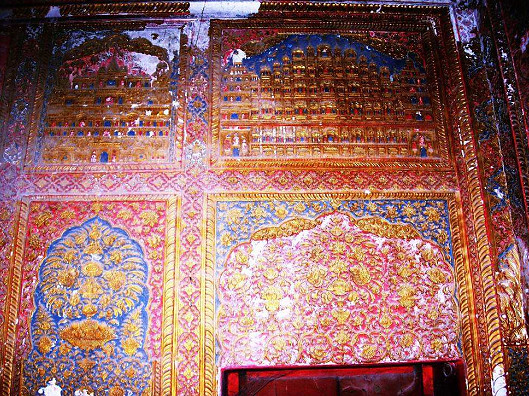
2. An unnamed Śaiva altar on the premises of Kamla Nehru's Girls' College in the vicinity of Jauharī Bāzār. A bas-relief of a Jina, heavily coated with ochre paint, above the entrance to the altar room and the altar itself, similar in shape to the one in Āmber's temple of Saṅghī Jhūṅthārāmjī, betray the Jain origin of the former temple turned into a school.

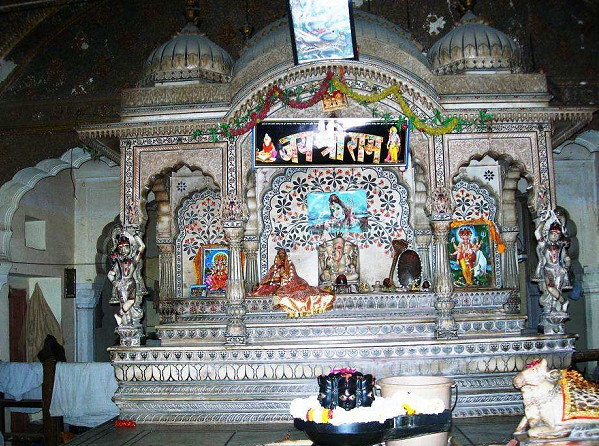
3. The temple of Gobardhannāthjī which belongs to Puṣti-mārg[27]. It is located outside of old Jaipur, on Galtā Road, in Mohan-bāḍī neighborhood[28]. Traces of conversion are evident: typical for Jain temples' interiors floral design (in blue, white and gold) on the walls was partially destroyed and replaced by murals, illustrating Vallabhācārya's hagiography. Unlike other Jain temples, the altar is situated not in the middle of the room, but in a deep niche in the wall. The niche is framed by a toraṇa of Jain origin: in the upper part there is a partially effaced but still visible image of a sitting Jina and at the bottom two basreliefs of Indrās with fly-whisks. Inside the altar there is a smaller copy of the famous Śrī Nāth from Nāthdvāra[29].
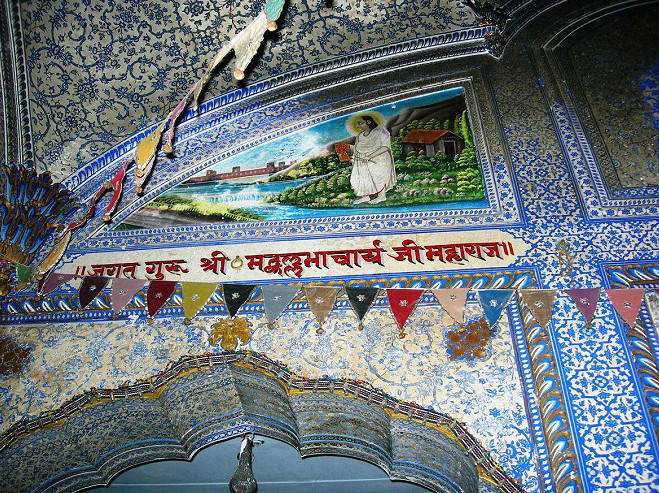
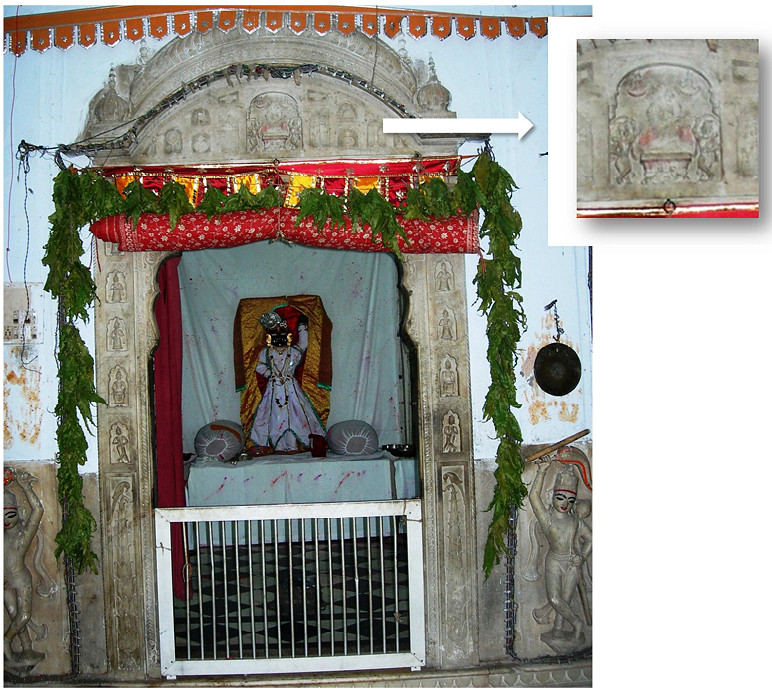
4. A large old havelī, situated outside of Jaipur, in a neighborhood, called Purāṇaghāṭ, off Āgrā road. Judging by the sign above the locked main entrance Mandir Śrī Fatehkunj Bihārījī - there is a Kṛṣṇa temple inside. The right wing of the havelī has a separate entrance into the Śaiva temple of Śrī Jagateśvar Mahādev. A square marble platform in the middle holds images of a four-faced liṅgam, Pārvatī and Nandī. There are also two additional side altars, which are typical of Jain temples - with images of Gaṇeś inside. The temple priest, Rām Caraṇ Vyās, was the only one, who agreed to discuss the circumstances of conversion, others temples' priests avoided conversation, insisting that they were ignorant of or ill-informed about the past events: Jagateśvar Mahādevjī indeed used to be a Jain temple. Rām Caraṇ doesn't know its original name. The liṅgam was consecrated here after dīvān Jhūṅthārām had killed Mahārājā Jai Siṅgh III. At first the havelī with the temple became royal or state property (khālsā), but during Mahārājā Rām Siṅgh II's rule (1835-1880) Rām Caraṇ's great grand-father Maṅgal Vyās had been assigned to perform pūjās here. There are documents in Jaipur Palace archives, which confirm his family's rights to the temple (Interview with Rām Caraṇ Vyās, recorded on January 31, 2006).
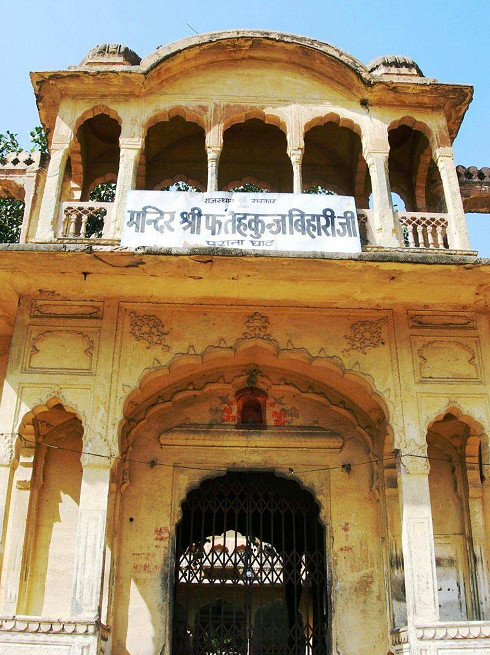
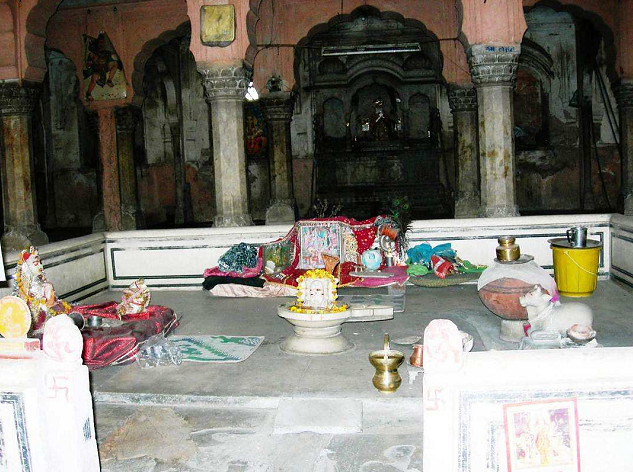
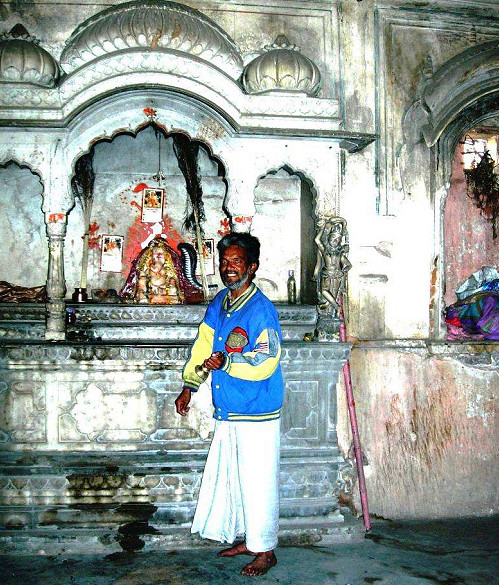
There are two possible scenarios of the havelī's history: the building may have originally been intended as a Jain temple[30], but later the confiscated property was divided between two confessions: Vaiṣṇavas and Śaivas; or it may have originally been a private residence with a caityālay (a home shrine) in the right wing, which belonged to a prominent Jain family of "zanānā party's" supporters.
If the information about Jaipur temples' conversions of 1830s may be at best qualified as "scarce", the name of the temple in question Saṅghī Jhūṅthārāmjī seems to be the only evidence that Jain temples of Āmber were affected by the events as well. Connection between Jhūṅthārām and the temple bearing his name, became clear, when I read a hand-out (a leaflet), which was offered to me by an employee of a prominent Jain temple, located in Jaipur's neighborhood of Moḍhī-khānā Śrī Digambara Jain Mandir Saṅghījī. The text said:
"This Jain temple was built four years after the foundation of Jaipur, in V.S. 1788 [i.e. in 1731 A.D.], by Saṅghī Ajit Dās, who was the son[31] of Saṅghī Mohan Dās - dīvān of Āmber - and an ancestor of Saṅghī Jhūṅthārām [italics added - E.K.]".
K.C. Kasliwal (1989: I; 173; 206f.) confirms this relationship and adds that in 1820 A.D. (i.e. in the beginning of the regency period) Jhūṅthārām had installed a vijay-yantra[32] in the above-mentioned Jaipur temple of Saṅghījī, built by his ancestor Ajit Dās.
Thus it became clear that Jhūṅthārām was a descendant of minister Mohan Dās, who had built the Jain temple of Vimalnāth in Āmber in 1657 A.D. during the reign of Rājā Jai Siṅgh I. Jhūṅthārām must have patronized his ancestor's temple actively and generously enough to leave his name in local residents' collective memory. Furthermore, one of my long-term Āmber informants confirmed that the temple in question had been converted in the beginning of Rām Siṅgh II's rule and added, that the grand havelī across from the temple used to belong to Jhūṅthārām during his stay in power (Oral communication with K.L.S., recorded on January 10, 2006). However, although residents of Āmber keep calling the temple by the Jain minister's name, the name itself doesn't say much to the majority of them. A chance interlocutor even suggested that Saṅghī Jhūṅthārām was "some Jain deity".
Conclusion
A plausible scenario of the temple's fate is as follows: there is no direct evidence - only a high probability - that Āmber's temple of Vimalnāth was desecrated and converted into a Śaiva temple during the events of 1760s. If it had been converted, it may or may not have been reclaimed by the Jain community after the turmoil was over. I shall remind here that the author of Buddhivilās briefly mentioned Brāhmaṇs' complaints to the Mahārājā that Jains kept removing liṅgams and reinstalling Jain images in their desecrated temples (Sāh 1964: 153). Since Jhūṅthārām's patronage of the temple is an established fact (otherwise his name wouldn't be associated with it), the temple must have belonged to the Jain community at least during the period of his political influence. Sometimes during the reign of Rām Siṅgh II it had been converted again and remained a Śaiva temple since then.
Therefore we may conclude that the oral tradition, recorded in Āmber and reproduced in the beginning of this paper, is not based on historical facts. There was no period in the history of Āmber /Jaipur kingdom, when a Jain minister kept building temples behind the ruler's back, so that the ruler had to restore justice by destroying Jain temples or converting them into Hindu ones. Why then did this tradition develop and what is its socio-cultural meaning?
It is easy to notice that both episodes of Jain temples' destruction/conversion coincide with periods of this community's increased political influence. In the first case - the events of 1760s - the text of the letter sent by the organizers of Indradhvaj Pūjā Mahotsav testifies to the absolute dominance of Jains at the court of Mahārājā Mādho Siṅgh I. The second case is even more telling: a Jain and his close relatives had been ruling Jaipur kingdom for fifteen years. From the standpoint of the regional culture this situation must have been perceived as unacceptable. Alan Babb (2002, 2004) has convincingly demonstrated that other communities of Rājasthān identified Jains first and foremost as Baniyās - a social group, whose identity (based on the principle of non-violence) made them the "cultural opposites" of Rājpūts. Historically Baniyās, especially Jains, have been close to power, holding high positions of revenue or chief ministers, managers of estate, etc. at the courts of Rājput rulers. Constant proximity to power must have roused their political ambitions on more than one occasion, especially during regencies or reigns of weaker rulers[33]. The oral tradition recorded in Āmber is an idiom of the popularly shared social truth: Jains' aspirations to political power were perceived as groundless, because they were not sanctioned by the regional culture of Rājasthān
In a more general sense the case study illustrates the coexistence of two alternative and mutually exclusive versions of the past. Most academic histories of Jaipur kingdom treat the Kacchāvas as the sole rightful subjects (makers) of history and politics and tend to ignore or minimize the roles of other ethno-confessional communities. Other communities' intellectuals attempt to cure the historical amnesia by representing their castes, confessions or ethnic groups as important social and political entities.
BIBLIOGRAPHY
Primary Sources
AST = Abstract of state trials held under the special commission at Jyepoor: for the trial of the ex-minister Sunghee Jotha Ram, his brother and son, and other persons implicated in a plot to subvert the local government, resulting in an assault upon the person of Major N. Alves, agent to the Governor-General, and the murder of Mr. Martin Blake, assistant agent to ditto: giving a general view of the proceedings ofthe special court before which the principal criminals were arraigned: with selected portions of the documents produced, the written defenses of Sunghees Jotha Ram and Hookum Chund, a summary of the evidence, translation of several important papers, and extracts from the Calcutta Courier having reference to the subject. Calcutta: G.H. Huttmann, Military Orphan Press, 1837.
Heber, Reginald. Narrative of a Journey through the Upper Provinces of India. Vol. I-II. Philadelphia: Carey, Lea and Carey, 1828.
Jacquemont, Victor. État Politique et Social De'l Inde du Sud en 1832: Extraits de son "Journal de Voyage" avec un Introduction de M. Alfred Martineau. Paris: Société de L'Histoire des Colonies Françaises et Librairie Ernest Leroux, 1934.
Sāh, Bakhtarām. Buddhivilās. Jodhpur: Rājāsthān Prācyavidyā Pratiṣṭhān, 1964.
Secondary Sources
Babb, Lawrence Alan. "Violence and the Construction of Trading-Caste Identity". Multiple Histories: Culture and Society in the Study of Rajasthan. Edited by Lawrence A. Babb, Varsha Joshi, Michael W. Meister, 15-38. Jaipur and New Delhi: Rawat Publications, 2002.
Babb, Lawrence Alan. Alchemies of Violence. Myths of Identity and the Life of Trade in Western India. New Delhi: Sage Publications, 2004.
Clémentin-Ojha, Cathérine. Le Trident Sur Le Palais. Une Cabale Anti-Vishnouite Dans un Royaume Hindou à L'Èpoque Coloniale. Paris: L'École Française D'Extrême Oriente, 1999.
Cort, John E. "The Jina as King". Vasantagauravam: Essays in Jainism. Edited by Jayandra Soni, 27-50. Mumbai: Vakils, Feffer and Simons, 2001.
Cort, John E. "A Tale of Two Cities: On the Origin of Digambar Sectarianism in North India". Multiple Histories: Culture and Society in the Study of Rajasthan. Edited by Lawrence A. Babb, Varsha Joshi & Michael W. Meister, 39-83. Jaipur & New Delhi: Rawat Publications, 2002.
Dhama, B. L. A Guide to Jaipur and Amber. Jaipur: The Hanuman Printing Press, 1955.
Hooja, Rima. History of Rajasthan. Delhi: Rupa & Co., 2006.
Horstmann, Monika. "The Rāmānandīs of Galtā". Multiple Histories: Culture and Society in the Study of Rajasthan. Edited by Lawrence A. Babb, Varsha Joshi & Michael W. Meister, 141-197. Jaipur & New Delhi: Rawat Publications, 2002.
Jain, Kailash Chand. Ancient Cities and Towns of Rajasthan. A Study of Culture and Civilization. Delhi: Motilal Banarasidas, 1972.
Jain, Shalin. "Interaction of the "Lords": the Jain Community and the Mughal Royalty under Akbar". Social Scientist 40, 3-4 (2012) 33-57.
Kasliwal, K. C. "Jain Community of Amer, Sanganer and Jaipur". Cultural Heritage of Jaipur. Edited by J. N. Asopa, 153-9. Jaipur: United Book Traders, 1982.
Kasliwal, Kasturcand. Khaṇḍelvāl Jain Samāj kā Vṛhad Itihās. Pratham Khaṇḍ. Jaipur: Jain Itihās Prakāśan Sansthān, 1989.
Nyāytīrth, Anūpcand. Jaipur Digambara Jain Mandir Paricay. Jaipur: Digambar Jain Mandir Mahāsaṅgh, 1990.
Pareekh, Nand Kishore. Royal Court and the Seraglio. Jaipur: Subodh Sahitya Sadan, 2000.
Prasad, R. N. Raja Man Singh of Amber. Calcutta: The World Press, 1966.
Roy, Ashim Kumar. History of the Jaipur City. New Delhi: Manohar, 1978.
Sarkar, Jadunath. A History of Jaipur c. 1503-1938. Delhi: Orient Longman, 1984.
Stern, Robert W. The Cat and the Lion: Jaipur State in the British Raj. Leiden: E.J. Brill, 1988.
© The Editor. International Journal of Jaina Studies 2012
For a brief review of the early Kacchāva rulers' religious beliefs see Jain 1972: 387-91. For Mān Siṅgh I (1589-1614) see Prasad 1966: 134-8; for Jai Siṅgh II (1699-1743) and his successors see Roy 1978: 160-80.
In fact there are seven Digambara Jain temples in contemporary Āmber (Nyàytãrth 1990: 93-100) and, to the best of my knowledge, at least three - Śvetāmbara ones.
Temple of Saṅghī Jhūṅthārām. Saṅghī - an honorary title of a Digambara Jain community (saṅgha) representative, who donates money for collective pilgrimages, in more general sense - a leader of a saṅgha. Jhūṅthārām - is a proper name.
According to my estimates, no more than fifteen to twenty Jain families permanently reside in Āmber.
Bhaṭṭāraks - domesticated Digambara monks, who in late medieval times replaced naked wandering monks (munis). They served as caste gurus and had "thrones" in major temples or monasteries (Cort 2002: 40f.).
The temple of Nemināth is one of the oldest Jain temples of Amber. Local residents call it "Sāṁvlājī" (from śyām - dark, black), because the central image - statue of Nemināth - is made of dark blue stone. About it see Nyāyatīrth 1990: 93f.
This is not entirely true. Besides the two anti-Jain campaigns, which are discussed in this paper, there was at least one more. The Śaiva guru of Mahārājā Rām Siṅgh II (1851-1880) enjoyed his royal patron's full support in persecution of the Vaiṣṇava sects of Jaipur. This long and bitter conflict became known as tilak-vivād (an argument over tilak) and was reconstructed in detail in Clémentin-Ojha 1999.
Literally: "a festival [on the occasion] of a pūjā to the flag of Indrā". Description of the festival see in Cort 2002: 58.
Galtā - a place to the east of Jaipur; the seat of Rāmānandī Vaiṣṇavas' sect. About Rāmānandīs see Horstmann 2002.
Mahānt Bālānand - the head of a sub-sect of Rāmānandīs in mid-18th century. About him see Roy 1978:191-4.
Hukum Cand's daughter was married to Amar Cand's son (personal communication with G.C. Hinduka).
According to Pareekh 2000: 66, a public performance by the popular musician and singer Bansidhar Bhatt became the source of the poisoning version. Bhatt sang, that on the fifth and the sixth day of spring the Mahārājā played Holī, on the seventh day he was given poison, and on the eighth day cremated.
Rānī Candrāvatī - mother of Jai Siṅgh III's only child and successor - Mahārājā Rām Siṅgh II (1835-1880).
Precisely for this reason I am not revealing here the names of prominent Jain intellectuals of Jaipur, who provided immeasurable and highly-appreciated help in this investigation.
According to Nyāytīrth 1990: 74f, this neighborhood is populated by Digambara Jains and initially used to be called Muni-bāḍī. The renaming probably occurred together with the temple's conversion, because the new name has a clear Vaiṣṇava connotation: Mohan is one of Kṛṣṇa's names.
Nāthdvāra is a town in the South-West of Rājasthān, famous for its temple, containing Puṣti-mārg's main object of worship - the image of Śrī Nāth.
According to John Cort 2001: 29, some "older urban temples in the north are in an architectural style modeled upon the residential havelīs".
It is more likely that Ajit Dās was not a son, but a grandson of Mohan Dās. The time difference between the construction of the Jaipur temple of Saṅghījī (1731) and the Āmber temple of Vimalnāth (1657) equals 74 years.
 Elena Karatchkova
Elena Karatchkova
